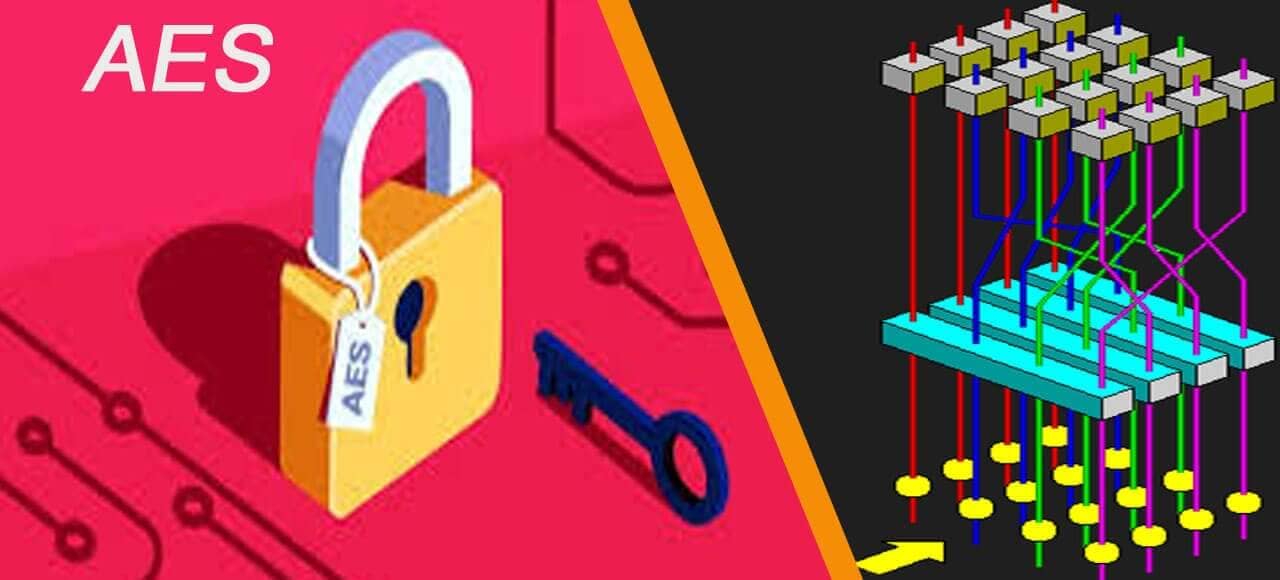By fostering a culture of security and privacy, encryption has established itself in the modern digital sphere.
In 2001, the Advanced Encryption Standard (AES) Encryption algorithm replaced the Data Encryption Standard as the accepted worldwide standard for encryption algorithms. This improved upon many of the disadvantages of the earlier method.
It was seen as the direction encryption will go in practical applications. The Advanced Encryption Standard has so far met the goals set for it at the time of its creation. There is still much room for growth.
What is Advanced Encryption Standard (AES)?
The United States government selected the symmetric block cipher known as the Advanced Encryption Standard (AES) to safeguard sensitive data.
To encrypt sensitive data, AES is used in hardware and software around the globe. For government computer security, cybersecurity, and the protection of electronic data, it is crucial.
The Data Encryption Standard (DES), which was becoming more susceptible to brute-force assaults, prompted the National Institute of Standards and Technology (NIST) to identify the need for an alternative in 1997.
The more modern and sophisticated encryption method, according to NIST, must be declassified and able to “secure sensitive government information long into the [21st] century.”
It was designed to provide adequate defenses against a variety of attack tactics and be simple to deploy in hardware and software as well as in constrained contexts, such a smart card.
With extra optional, free usage in public or private, commercial or noncommercial programs that provide encryption services, it was developed for the U.S. government.
However, there are restrictions imposed by U.S. export control on nonprofit groups who choose to employ AES.
AES encryption principles
There are three block ciphers of this encryption.
- A block of messages may be encrypted and decrypted using AES-128 using a 128-bit key length.
- A block of messages may be encrypted and decrypted using AES-192 using 192-bit keys.
- A block of messages may be encrypted and decrypted using AES-256 using a 256-bit key length.
Each cipher uses cryptographic keys of 128, 192, or 256 bits to encrypt and decode data in blocks of 128 bits.
Secret key ciphers, sometimes referred to as symmetric ciphers, employ the same key for both encryption and decryption. The secret key must be known by both the sender and the recipient.
Information is divided into three categories by the government: confidential, secret, and top secret. The Confidential and Secret levels may be secured using any key length. Key length requirements for Top Secret information are 192 or 256 bits.
For 128-bit keys, there are 10 rounds, for 192-bit keys, there are 12, and for 256-bit keys, there are 14 rounds.
The input plaintext is processed through a number of phases in a round, including substitution, transposition, and mixing, to produce the final output of ciphertext.
Numerous modifications that need be made to data stored in an array are specified by the AES encryption method.
The data is initially organized into an array, and then the cipher modifications are repeated through a number of encryption rounds.
Data substitution using a substitution table is the first change in the AES encryption algorithm. In the second transformation, data rows are moved.
Columns are mixed in the third. Each column goes through the final transformation using a different portion of the encryption key. More rounds are required to finish longer keys.
What are the features of AES?
The new algorithm had to be a block cipher that could handle 128-bit blocks and use keys that were 128, 192, or 256 bits in size, according to NIST.
The following factors were also taken into consideration while deciding on the next encryption algorithm.
1. Security
The capacity of competing algorithms to withstand assault in comparison to other ciphers presented was to be evaluated. The most crucial aspect of the competition was to be security strength.
2. Cost
The potential algorithms were to be assessed on their computational and memory efficiency with the goal of being published on a worldwide, nonexclusive, and royalty-free basis.
3. Implementation
The algorithm’s adaptability, appropriateness for implementation in hardware or software, and general simplicity were all things to take into account.
Choosing the new AES algorithm
The National Security Agency and the international cryptography community conducted a preliminary investigation on fifteen symmetric algorithm ideas that were in competition (NSA).
NIST chose five algorithms in August 1999 for a more thorough examination:
- MARS, which was presented by a large IBM Research team;
- RSA Security’s RC6 submission;
- Rijndael, presented by Joan Daemen and Vincent Rijmen, two Belgian cryptographers;
- serpent, put out by Lars Knudsen, Eli Biham, and Ross Anderson; and
- Several researchers from Counterpane Internet Security, including renowned cryptographer Bruce Schneier, submitted Twofish.
All of the aforementioned implementations have undergone comprehensive testing in the ANSI, C, and Java programming languages for:
- dependability and speed of the encryption and decryption procedures;
- setup time for the key and algorithm; and
- both in hardware- and software-centric systems, resistance against a variety of threats.
Members of the worldwide cryptography community, including those teams who attempted to crack their own submissions, undertook thorough studies.
In October 2000, the Rijndael encryption was chosen as the suggested algorithm for AES after significant discussion, study, and criticism.
The U.S. Federal Information Processing Standards (FIPS) PUB 197 standard was released by NIST and approved by the secretary of commerce in December 2001.
In 2002, AES became a standard for the federal government. The International Organization for Standardization (ISO)/International Electrotechnical Commission (IEC) 18033-3 standard, which details block ciphers for data secrecy, also includes it.
The American government declared that AES may be used to safeguard secret material in June 2003.
The first publicly available and open cipher authorized by the NSA for Top Secret material, AES quickly became the standard encryption method for safeguarding sensitive data.
The NSA’s Information Assurance Directorate will deploy AES as one of its encryption algorithms to safeguard the nation’s security systems.
The U.S. government’s effective deployment of AES encouraged its broad adoption by the commercial sector. The AES algorithm is now the most often used one in symmetric key encryption.
Experts in security and cryptography have a high degree of trust in AES because to the open selection procedure established by NIST.
Difference between AES-128 and AES-256
Security professionals believe that AES is resistant to brute-force assaults. A threat actor uses a brute-force assault when they try every key combination until they find the right one.
Therefore, the key size used for AES encryption has to be sufficiently big to prevent it from being cracked by contemporary computers, even taking Moore’s law-based improvements in processor performance into account.
A 128-bit encryption key is much easier for brute-force attacks to guess than a 256-bit key, but since the latter takes so long to guess, even with a lot of computing power, it is unlikely to be a problem in the near future because a malicious actor would need to use quantum computing to produce the necessary brute force.
Even still, 256-bit keys might take longer to execute and need more processor resources. 128-bit keys are perhaps a preferable choice when power is a factor, especially on compact devices, or latency is likely to be an issue.
The weakest link in a system is where hackers will try to get access. Regardless of whether a system uses a 128-bit key or a 256-bit key, the encryption of that system is often not done in this way.
Users should confirm that the program meets their needs, secures user data as intended, and has no flaws in the whole procedure before deciding whether to use it.
Furthermore, there should be no doubt or ambiguity about the management and storage of data. Users should be aware of the location of the cloud, for instance, if data is stored there.
Most essential, the security software should be simple to use so that users don’t have to employ unsafe workarounds to complete their tasks.
Difference between AES and RSA
AES is often used to safeguard data that is at rest. AES has many uses, including:
- Self-encrypting disk drives
- database security
- storage encryption
Web browsers often employ the RSA (Rivest-Shamir-Adleman) algorithm to establish connections to websites, as well as in virtual private network (VPN) connections and a variety of other applications.
RSA is the cornerstone of asymmetric cryptography, in contrast to AES, which uses symmetric encryption.
By encrypting and decrypting plaintext using the same key, or secret key, symmetric encryption transforms it into ciphertext. The fact that two related keys—a public key and a private key—are used for encryption gives rise to the name “asymmetric.”
If the public key is used for encryption, only the associated private key may be used for decryption, and vice versa. RSA keys are often used when there are two distinct endpoints.
Although RSA encryption performs poorly, it is effective at securing data transfers across borders.
The answer is to combine RSA with AES encryption, which will give you the security of RSA and the performance of AES. You may do this by creating a temporary AES key and encrypting it using RSA.
Difference between AES and DES
DES algorithms were created by the U.S. government more than 40 years ago to guarantee that all government systems followed the same, secure protocol to enable interoperability.
Up until 1999, when researchers used a distributed computer system to crack the 56-bit key of the DES algorithm, the algorithm was the cornerstone of government encryption.
The American government decided to employ AES to safeguard confidential information in 2000. Some applications continue to utilize DES for backward compatibility.
Both of the industry standards use symmetric block ciphers, although AES is a more efficient technology. The major advantage is the variety of key lengths available.
The length of the key used to protect the communication—128-bit, 192-bit, or 256-bit keys—is closely correlated with the amount of time needed to break the encryption technique.
As a result, AES is far more secure than DES’s 56-bit key because the encryption is so much quicker, it is perfect for software, firmware, and hardware that demands high throughput or low latency.
Attacks on AES encryption
Since the finalization of the AES standard in 2000, research on attacks on the encryption algorithm has continued. Numerous researchers have written attacks against AES variants that use shorter rounds.
AES encryption can be broken in a number of different methods, according to researchers:
- They identified a potential related-key attack in 2009. This cryptanalysis looked at how a cipher works with various keys in an effort to break it. The related-key attack was only found to pose a hazard to AES systems that were set up improperly.
- AES-128 was the target of a known-key attack in 2009. It was possible to decipher the encryption’s structure using a known key. The danger was, however, only marginal since the breach only affected an eight-round variant of AES-128, not the usual 10-round variant.
Side-channel attacks pose a serious threat to AES encryption. Side-channel assaults strive to retrieve system leaks of information rather than making a brute-force assault effort.
However, side-channel attacks may limit the amount of viable combinations needed to brute force attack AES.
The goal of side-channel attacks is to reverse-engineer the cryptography system of a computer device by gathering knowledge about what the device does while it performs cryptographic operations.
To learn more about how the system is handling the AES encryption, these attacks may make advantage of time data, such as how long it takes the computer to complete calculations, electromagnetic leakage, acoustic cues, and optical data, such as from a high-resolution camera.
In one scenario, by carefully observing the cipher’s shared usage of the processors’ cache tables, a side-channel attack was successfully exploited to infer the AES-128 encryption keys.
By avoiding potential data leaks, side-channel attacks may be lessened. Randomization strategies may also aid in removing any connections between data secured by the encryption and any leaked data that could be gathered via a side-channel attack.
Is AES safe or not?
Security professionals believe that AES is safe when used correctly. It’s encryption keys must be secured, nevertheless. If a hacker obtains the encryption key, even the most robust cryptographic systems may be exposed.
To be sure that AES keys are secure:
- Create secure passwords.
- Use password managers.
- Implement multifactor authentication and make it mandatory (MFA).
- Install firewalls and anti-virus programs.
- To protect staff against phishing and social engineering scams, provide security awareness training.
Final thoughts
You could understand why AES encryption is considered the “gold standard” of encryption methods after reading this article.
One of the most valuable tools available today is characterized by its speed, adaptability, and resistance to all types of cyberattacks.
And we are incredibly lucky it exists.
Do you have any questions still now? Please don’t hesitate to mention them in the comment section of this guide, and we’d be happy to have our experts answer them for you. Your can also share your experience and opinion with our readers.
Recommended articles:
Artificial intelligence | types, categories, applications, examples and goals
What is data science? All you need to know about data science
What is cyber security? All you need to know about cyber security
What is Edge Computing? Advantages and 4 main disadvantages of Edge Computing
What is quantum computing? Advantages, disadvantages and quantum technologies
What is cloud computing? Types, advantages and disadvantages





I couldn’t refrain from commenting. Very well written!